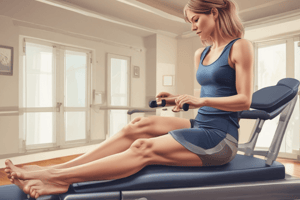Podcast
Questions and Answers
What are the general consequences for movement control of upper motor neuron (UMN) syndromes?
What are the general consequences for movement control of upper motor neuron (UMN) syndromes?
Loss of voluntary control, exaggerated reflexes, and increase in muscle tone.
What is the most common type of stroke?
What is the most common type of stroke?
- Transient Ischemic Attack
- Ischaemic Stroke (correct)
- Subarachnoid Hemorrhage
- Intracerebral Hemorrhage
Match the following terms with their definitions:
Match the following terms with their definitions:
Ataxia = Inability to coordinate muscle activity Apraxia = Loss of the ability to execute familiar movements Aphasia = Impairment of language Hemiparesis = Weakness on one side of the body
The Babinski sign is a typical sign of upper motor neuron damage.
The Babinski sign is a typical sign of upper motor neuron damage.
What is a Transient Ischemic Attack (TIA)?
What is a Transient Ischemic Attack (TIA)?
Spasticity is dependent on the speed of muscle stretch.
Spasticity is dependent on the speed of muscle stretch.
What is the significance of the middle cerebral artery (MCA) in stroke?
What is the significance of the middle cerebral artery (MCA) in stroke?
Which risk factor doubles the risk of stroke every decade after the age of 60?
Which risk factor doubles the risk of stroke every decade after the age of 60?
What defines neurological recovery after a stroke?
What defines neurological recovery after a stroke?
How long does peak spontaneous neurological recovery from stroke typically occur?
How long does peak spontaneous neurological recovery from stroke typically occur?
Flashcards are hidden until you start studying
Study Notes
Stroke and Rehabilitation
- Upper motor neuron (UMN) syndromes impact voluntary movement due to diminished descending control.
- Loss of cortical input results in hyperreflexia, spasticity, and disinhibition of spinal reflexes.
- Main symptoms of UMN dysfunction include spasticity, clonus, and the Babinski sign, indicating loss of neurological control.
- Stroke, or cerebrovascular accident (CVA), causes neurological damage due to impaired blood flow, often characterized by sudden onset of symptoms.
Types of Stroke
- Ischemic Stroke: Most common (80%), caused by thrombus or embolism; can result in transient ischemic attacks (TIAs) with identical symptoms lasting less than 24 hours.
- Intracerebral Hemorrhage: Accounts for 15% of strokes, typically linked to blood vessel rupture.
- Subarachnoid Hemorrhage: Represents 5% of strokes, often caused by aneurysm rupture.
Stroke Incidence and Risk Factors
- Approximately 60,000 new strokes occur each year in Australia.
- Risk factors include diabetes, hypertension, age (risk doubles every decade after 60), smoking, obesity, and excessive alcohol consumption.
Mechanisms of Stroke
- Ischemic Mechanisms:
- Cerebral embolism where thrombus dislodges, most commonly affecting the middle cerebral artery.
- Lacunar stroke involves small lesions from occlusions in deep branches of large vessels, often resulting in motor or sensory symptoms.
- Hemorrhagic Mechanisms:
- Cerebral hemorrhage typically from ruptured aneurysms leading to progressive neurological symptoms.
- Subarachnoid hemorrhage causes vasospasm and symptoms resembling ischemic strokes.
Neurological Symptoms of Stroke
- Symptoms vary based on the location of the lesion:
- Middle Cerebral Artery (MCA) affects arm and face strength more than leg strength.
- Anterior Cerebral Artery (ACA) leads to weakness in the contralateral leg and possible gait apraxia.
- Posterior Cerebral Artery (PCA) primarily causes visual field deficits.
Recovery Mechanisms and Rehabilitation
- Optimal recovery occurs within the first 1-3 months post-stroke, involving spontaneous reorganization and rehabilitation.
- Functional recovery strategies may include compensatory movement learning and promoting neuronal connections.
- Rehabilitation success depends on motivation, therapy quality, and timely intervention, as recovery can plateau if delayed.
Key Rehabilitation Techniques
- Effective rehabilitation strategies involve:
- Providing command signals to guide movement.
- Feedback mechanisms to compare intended versus actual movements.
- Techniques like constraint-induced therapy, EMG-assisted functional electrical stimulation, and proprioceptive stimulation of affected limbs.
Definitions of Related Terms
- Ataxia: Lack of coordination during voluntary movements.
- Apraxia: Loss of ability to perform familiar tasks despite intact motor function.
- Aphasia: Difficulty producing or comprehending language.
- Agnosia: Inability to recognize sensory stimuli when basic senses function normally.
- Dyskinesia: Abnormal and involuntary movement patterns.
- Hemiparesis: Weakness on one side of the body, affecting movement capability.
- Dysphagia: Difficulty swallowing, leading to potential nutritional issues.
Studying That Suits You
Use AI to generate personalized quizzes and flashcards to suit your learning preferences.




